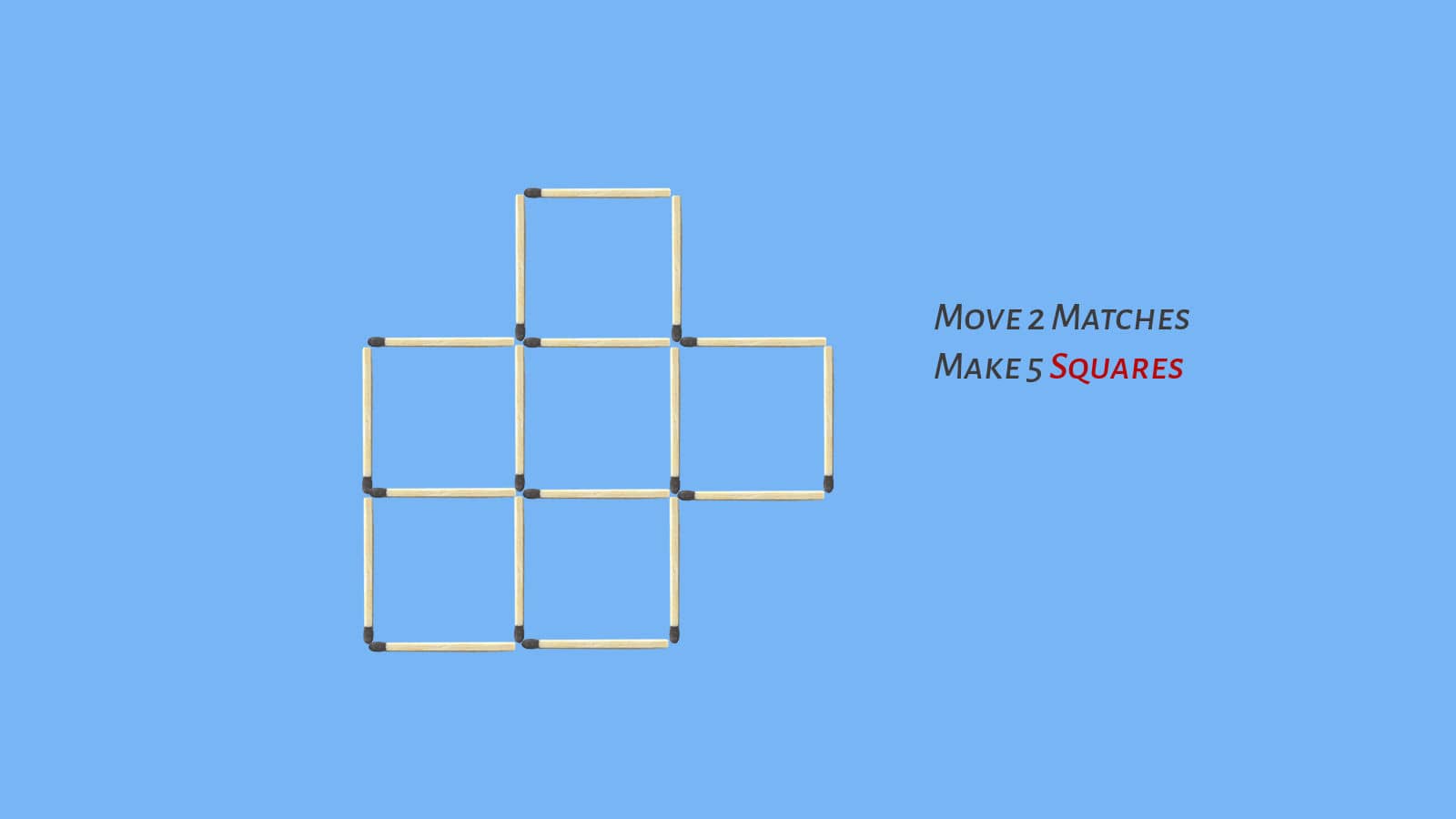
6 squares matchstick puzzle: Move 2 sticks to make 5 squares
Move 2 sticks to make 5 squares from the 6 squares matchstick puzzle figure. How many ways can you do it?
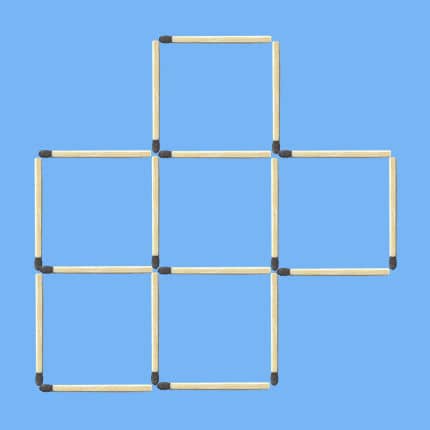
You have 10 minutes to solve the puzzle.
Restriction: The solution matchstick figure must not have any overlapping or loose sticks that are not a part of any square.
Enjoy solving the problem.
If you can’t find the solution or feel curious about how we have solved the puzzle step by step, the solution for you follows.
Solution to the 6 squares matchstick puzzle: Move 2 sticks to make 5 squares
Analysis of the structure and you get assurance of an easier way to the solution
At first, the problem seems to be complex because of the relatively large number of squares and sticks. Do you think the problem would be difficult to solve?
Instead of just looking at the puzzle figure focus on what figure finally you have to form—it is just a 5 square figure. There is a small difference in the number of squares between the starting figure and the target solution figure. On top of this, now you notice, you have to move only 2 matchsticks.
These two facts assure you that the problem should not be difficult to solve after all. This is what we call confidence boosting assurance of a not so difficult solution.
It helps you to solve the problem quickly and easily by boosting your confidence.
Analysis of the structure to evaluate possible approaches and deciding on the most promising approach: Move 2 sticks to make 5 squares matchstick puzzle
You know of two main approaches of solving matchstick puzzles—End State Analysis Approach and Common stick analysis approach coupled with deductive reasoning.
The first is the End State Analysis Approach in which the promising possible end configurations are compared one by one with the starting puzzle figure for maximum similarity. This approach gives you quick and clean solution when the possible end states are few.
More frequently, this condition is satisfied when the number of sticks are just enough to form independent squares or triangles without any sharing or common stick between two closed shapes (square or triangle).
Two of the notable puzzles of this type we have solved earlier are the 5 squares to 4 squares in 2 stick moves and 5 squares to 4 squares in 3 stick moves.
In this puzzle of ours, the total number of sticks is 18, which is 2 short of the maximum number of sticks required to form 5 independent squares. There will then be 2 shared or common sticks in the final solution figure. Here, it may not be easy to imagine possible solution figures.
So we decide to follow the second approach of common stick analysis coupled with deductive reasoning.
Initial conclusions from common stick analysis and deductive reasoning: Move 2 sticks to make 5 squares matchstick puzzle
In the second approach, the number of common sticks in the starting puzzle figure is compared with the number in the solution figure.
The number of common sticks is 6, quite a large number, in the starting figure. And the number of common sticks is 2 in the solution figure.
The figure below identifies the common sticks in the starting 6 squares.
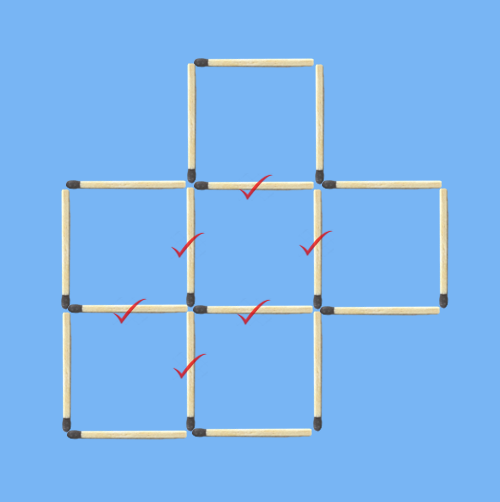
As you know—each common stick reduces the number of sticks required to form 5 squares by 1.
The number of sticks required to form 5 independent squares with no common stick is, 5×4=20. When 5 squares are to be formed by the existing 18 sticks, 20−18=2 number of sticks must be common between two pairs of squares.
So it is surprising that in only 2 stick moves you have to reduce the number of common sticks by 4.
What does it signify? It implies,
At least in 1 stick move you should target to nullify the maximum number of common sticks—more the merrier.
With this initial knowledge, try to find out how you can reduce the number of common sticks to the maximum extent with 1 single stick move. It should be easy to identify the square marked A contributing 4 common sticks to the puzzle figure of 6 squares.
If you remove any of the four sides destroying this square, 4 common sticks would be nullified at a single move.
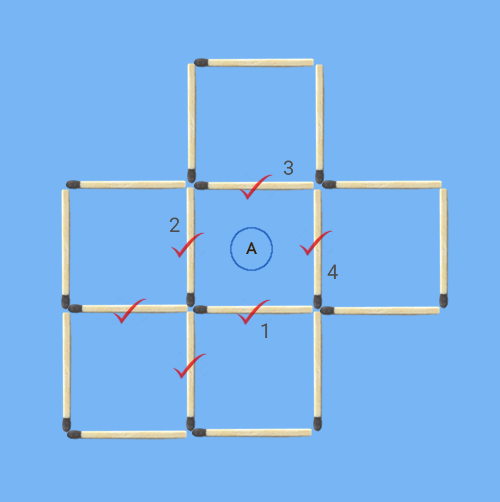
So take up stick move analysis on this square A that you have identified as your target of attention by common stick analysis.
It is decided not to disturb the stick number 3 and 4 as both would create 3 orphan sides of a square—impossible to set right in 1 remaining move.
What about the sticks 1 and 2?
Removing any of these two would create 2 numbers of orphan sticks. In addition, in each of these two options, 5 common sticks are eliminated.
Each of these two choices should give us a solution. We call these as the most promising actions for solution.
Select stick 1 first for moving as a trial.
Second stage: Selecting stick 1 as first stick to move: First solution to Move 2 sticks to make 5 squares matchstick puzzle
The result of selecting the stick 1 as first move is shown below. The sticks around are numbered for easy reference.
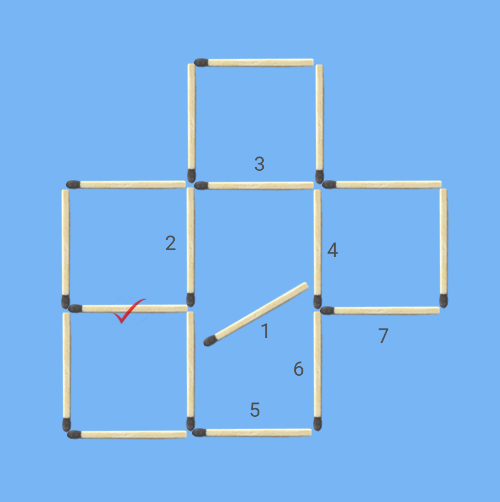
Now with stick 1 free, you have no other option than to select the stick 5 for the second move. Notice that now the figure has only 1 common stick.
The solution is now clear. Just complete the incomplete square E with the two sticks 1 and 5 moved. It already has two existing sides, 6 and 7. This is the first solution.
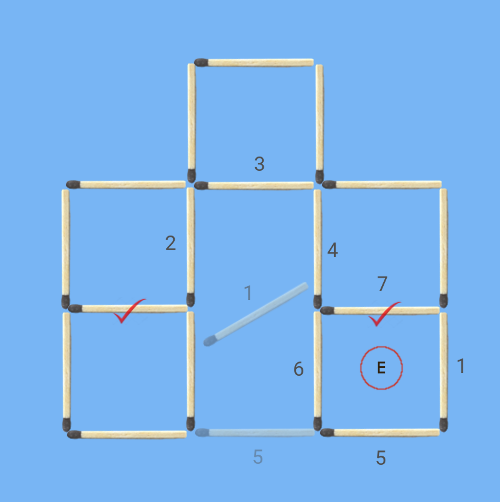
Notice that stick 7 has taken up a new role of the second common stick so that conditions for creating 5 squares with 18 sticks are fully satisfied.
How many solutions to the Move 2 sticks to make 5 squares matchstick puzzle?
You already know that if you had moved stick 2 first instead of stick 1, there could have been a second solution. And indeed it is so. The second and last solution by moving stick 2 first and then stick 8 next is shown.
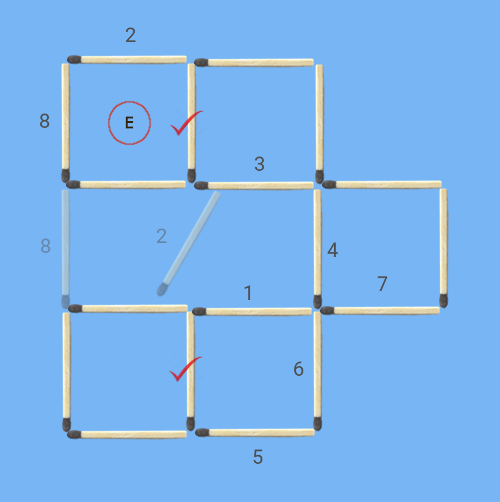
To us, these are the only two possible solutions.
First and most critical reason that these two are the only possible solutions is,
No solution would be possible without destroying the square A that we identified in the beginning.
You may try destroying any square other than square A first.
Try out. After all, this is not maths! It might yet be possible.
Think other way round: Create a new puzzle for your friends
Now that you know clearly how 5 squares can be formed from 6 squares by moving two sticks, it should also be possible to form 6 squares from any of the two of our final solution figures made up of 5 squares, isn’t it?
And that would easily be a new puzzle that you may entertain your friends with.
End note
Last, to solve matchstick puzzles you don’t need to know maths or any other subject. You just have to identify key patterns and use your inherent analytical reasoning skills to home in to the solution with assurance and speed.
The way to the solution, the approach, the thinking are more important than the solution itself. The concepts and methods stay with you and are enriched as you solve more and more problems.
Know how to solve difficult problems easily without wasting time on random attempts
Our ebook on puzzle solutions by innovative methods will show you just that.
Puzzles for Adults: 50 Brain Teasers with Step-by-Step Solutions: Boost Your Power of Problem Solving
BUY the eBook Amazon Kindle version here, from Google Play here and Paperback here.
Second book on Innovative Solutions to Matchstick Puzzles from Suresolv

BUY Creative Matchstick Puzzles Innovative Solutions eBook Amazon Kindle version
BUY the paperback here.
Puzzles you may enjoy
Easy to hard brain teasers with systematic solutions
Challenging brain teasers with solutions: Long list.
This will always be the most up-to-date full list with the brain teasers classified into categories that can be browsed separately.
You may also click on the category term link below to enjoy the brain teasers that are classified in the present category.
For example, if the category term link shown below is "Riddle", click on it to go through all the Riddles.

